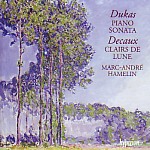Dukas’ Piano Sonata is the French “Hammerklavier”, a massive work nearly 45 minutes long written in an uncompromising style that never courts popularity. That said, its tone of high seriousness does not preclude a wealth of attractive ideas, nor does the lack of gratuitous virtuoso display mean that the piece is technically easy. Although not the tour-de-force exemplified in such works as the Alkan Concerto for Solo Piano, this sonata’s technical and formal challenges play to Hamelin’s strengths in a similar way, making this the finest version of the piece yet recorded. His transcendental virtuosity always seems most persuasive when placed in the service of clarifying structural detail, and this quality is very much in evidence in the sonata’s large outer movements.
The finale in particular benefits from Hamelin’s unerring ability to see the piece whole and to place each climax within a coherent musical framework. In the first movement it’s very rewarding to hear such well-characterized first and second subjects without any need to sacrifice forward momentum and flow. The skittish scherzo and predominantly lyrical slow movement offer fewer interpretive problems, but they are just as persuasive, the former uninhibitedly brilliant and the latter eloquently soulful. Like the Beethoven mentioned above, Dukas’ sonata never will be an easy piece, and it isn’t meant to be, but in Hamelin’s hands it becomes a very rewarding and frequently beguiling listening experience, one well worth your time and effort.
As a composer, Abel Decaux made Dukas, and even Duparc, look positively prolific. Clairs de lune is his only known work. It was recorded relatively recently by Frederic Chiu (Harmonia Mundi), a performance slightly slower and more atmospheric than this one, oddly coupled to works by Ravel and Schoenberg. Hamelin’s dexterously linear approach has the effect of highlighting the music’s harmonic audacity, and preference between the two must remain very much a matter of personal choice. I lean slightly toward Chiu while respecting Hamelin tremendously, not just for the sheer technical mastery of the performance, but also for his intelligence in devising this coupling, an intriguing illustration of the Yin/Yang, Truth/Beauty duality in French piano music around the turn of the 20th century. First-class sonics complement a program offering fuel for both the heart and the mind in equal measure. [6/1/2006]
































